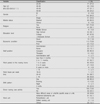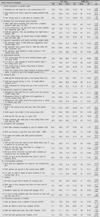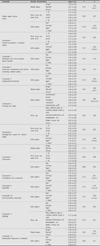Abstract
Purpose
The purpose of this study was to investigate the patient safety culture in Korean nursing homes using the Nursing Home Survey Patient Safety Culture (NHS-PC), a valid tool, provided by the Agency for Healthcare Research and Quality (AHRQ) and to compare the results with AHRQ data.
Methods
Administrators and staff (N=151) of six nursing homes in Seoul, Busan, Kyeonggi Province and Gyeongsangnam Province completed the survey in July, 2010. The data were analyzed using descriptive statistics, positive response rate, t-test, ANOVA, DUNCAN, Cronbach's α.
Results
The total mean (SD) positive response rate for patient safety culture was not significantly different from the AHRQ data. For composite levels, the results of 'handoffs' were significantly higher, and the results of 'feedback and communication about incidents' and 'nonpunitive responses to mistakes' were significantly lower than the AHRQ data.
Figures and Tables
Table 3
Comparison of Average Positive Response Rate for Patient Safety Culture Composite-Level of Korea and AHRQ Data

References
1. Agency for Healthcare Research and Quality. Patient safety culture surveys. 2004. Retrieved January 14, 2009. from http://www.ahrq.gov/qual/nhsurvey08/nhguide1.htm.
2. Ahn SH. Analysis of risk factors for patient safety management. J Korean Acad Nurs Adm. 2006. 12:373–384.
3. Bonner AF, Castle NG, Perera S, Handler SM. Patient safety culture: A review of the nursing home literature and recommendations for practice. Ann Longterm Care. 2008. 16(3):18–22.
4. Castle NG, Sonon KE. A culture of patient safety in nursing homes. Qual Saf Health Care. 2006. 15:405–408. http://dx.doi.org/10.1136/qshc.2006.018424.
5. Chen IC, Li HH. Measuring patient safety culture in Taiwan using the Hospital Survey on Patient Safety Culture (HSOPSC). BMC Health Serv Res. 2010. 10:152–161. http://dx.doi.org/10.1186/1472-6963-10-152.
6. Feng X, Bobay K, Weiss M. Patient safety culture in nursing: A dimensional concept analysis. J Adv Nurs. 2008. 63:310–319. http://dx.doi.org/10.1111/j.1365-2648.2008.04728.x.
7. Handler SM, Castle NG, Studenski SA, Perera S, Fridsma DB, Nace DA, et al. Patient safety culture assessment in the nursing home. Qual Saf Health Care. 2006. 15:400–404. http://dx.doi.org/10.1136/qshc.2006.018408.
8. Institute of Medicine. To err is human: Building a safer health system. 2000. Washington: National Academy Press.
9. Jeong GH, Oh YH, Lee YG, Son CK, Park BM, Lee SY, et al. 2011 survey for aging (2012-04). 2012. Seoul: Ministry of Health and Welfare, & Korea Institute for Health and Social Affairs.
10. Jeong J, Seo YJ, Nam EW. Factors affecting patient safety management activities at nursing divisions of two university hospitals. Korean J Hosp Manage. 2006. 11(1):91–109.
11. Jeong KH, Cho AJ, Oh YH, Sunwoo D. The status of caregiving for frail older persons and family caregiving burden. 2001. Seoul: Korea Institute for Health and Social Affairs.
12. Kang MA, Kim JE, An KE, Kim Y, Kim SW. Physicians' perception of and attitudes towards patient safety culture and medical error reporting. Korean J Health Policy Adm. 2005. 15(4):110–135.
13. Kim EK, Kang MA, Kim HJ. Experience and perception on patient safety culture of employees in hospitals. J Korean Acad Nurs Adm. 2007. 13:321–334.
14. Korea National Statistical Office. Statistical report on the aged 2010. 2011. Retrieved September 9, 2011. from http://kostat.go.kr/portal/korea/kor_nw/2/1/index.board?bmode=read&aSeq=250718&pageNo=1&rowNum=10&amSeq=&sTarget=title&sTxt.
15. Lee YM. Safety accident occurrence to perceptions of patient safety culture of hospital nurses. J Korea Acad Ind Coop Soc. 2012. 13(1):117–124.
16. Ministry of Health and Welfare. 2009 Statistics on the aged. 2009a. Retrieved October 1, 2009. from http://www.mw.go.kr/front_new/jb/sjb030301vw.jsp?PAR_MENU_ID=03&MENU_ID=031604&CONT_SEQ=264473&page=1.
17. Ministry of Health and Welfare. 2009 Elderly statistics. 2009b. Retrieved October 1, 2009. from http://www.mw.go.kr/front_new/jb/sjb030301vw.jsp?PAR_MENU_ID=03&MENU_ID=031604&CONT_SEQ=264473&page=1.
18. National Health Insurance Corporation. Number of long-term care facilities. 2012. Retrieved October 20, 2012. from http://www.longtermcare.or.kr/portal/site/nydev/MENUITEM_ORGSEARCH/.
19. Nunnally JC. Psychometric theory. 1978. 2nd ed. New York: McGraw-Hill.
20. Park SJ, Kang JY, Lee YO. A study on hospital nurses' perception of patient safety culture and safety care activity. J Korean Crit Care Nurse. 2012. 5(1):44–55.
21. Yoon SH, Wu XL. Content analysis of patient safety culture in nursing homes. J Korean Acad Nurs Adm. 2013. 19:118–127. http://dx.doi.org/10.11111/jkana.2013.19.1.118.




 PDF
PDF ePub
ePub Citation
Citation Print
Print






 XML Download
XML Download